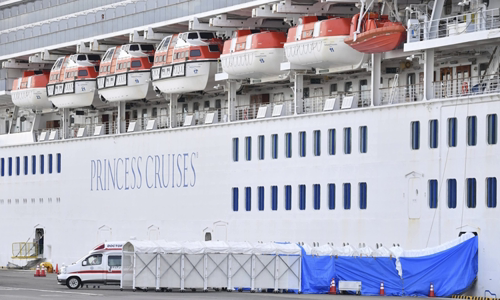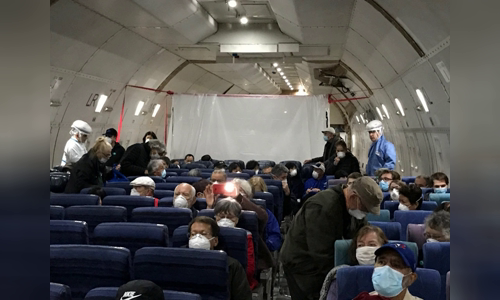On the last night of the two-week cruise, Captain Diamond Princess announced that a 9-day yacht departing man was positive for nCoV.
Despite everyone's worries, group activities were held on board, while the Diamond Princess cruise headed towards the port of Yokohama, the second largest city in Japan. Passengers enjoy steak for dinner, watch performances in the 700-seat theater, or squeeze in bars and dance floors.

An ambulance was parked in the port of Yokohama, Japan to transport nCoV-infected patients on the Diamond Princess to the hospital on February 7 Photo: Reuters
Diamond Princess's management company even hurriedly organized more entertainment activities such as table tennis, karaoke and dance classes to serve passengers, when they are expected to stay for one more day for the health authorities to check. symptoms of nCoV infection.
Tyler and Rachel Torres, newly married couple from Texas, USA, that night came to see a performance at the theater on the yacht in the hope of enjoying the full romantic trip. "We don't really care about the dangers of leaving the room. Because this is a honeymoon, we don't want to waste the last moments on the yacht," Rachel said.
When the passengers were immersed in the music, they were most likely exposed to nCoV, a virus originating in Wuhan, China that killed more than 2,600 people. It took the Japanese authorities more than 72 hours to impose the Diamond Princess quarantine order, since receiving the first notification of Hong Kong passengers traveling by train last month infected with nCoV.
Hong Kong authorities reported the case to the Japanese Ministry of Health early in the morning of February 2. However, a spokesman for Princess Cruises company, owner of Diamond Princess, said that until February 3, they had received "official confirmation" and informed passengers that night.
Only when parties and concerts are finished at around 23:00 on February 3, passengers are advised to stay in the room. After the cruise arrived at Yokohama Port, medical staff went to each room to check the temperature, cough symptoms and conduct nCoV tests with some passengers.
During the screening, the Diamond Princess management decided to cancel the activities they had planned. However, people still gathered on the train, queuing for buffet, sharing ladles, tongs, as well as salt and pepper shakers on the table.
Passengers thought the departure was only delayed for a day, until the captain made a new announcement while they had breakfast on February 5. He said Japan's Ministry of Health has confirmed 10 cases of nCoV on board, so passengers need to return to their rooms immediately and they will be quarantined for the next 14 days.
With the situation stuck in the cabin, thousands of Diamond Princess passengers began to recall the incidents that could have caused them to be infected with nCoV before the yacht was quarantined. They wondered why the on-board buffet was still held even though the board of directors knew of the infected Hong Kong passengers. Art auctions, afternoon tea parties, quizzes and mahjong suddenly bring a sense of disaster.
In order to allay fears, a spokesman for Princess Cruises said the crew conducted a "daily cleaning and sanitation" using biocides "believed to kill corona viruses quickly in for 30 seconds ". However, the number of nCoV infections on Diamond Princess is increasing day by day.
What makes the passengers more confused is the feeling of information being silenced. A few hours after the Japanese Ministry of Health announced to the media, they only learned about the number of new cases of nCoV reported. This situation caused them to count the number of ambulances queuing up on the dock to guess the number of new cases that day. Some Japanese passengers hung banners on the yacht's balcony, including the words: "Lack of medicine and serious information."
In the isolation process, policies and practices are constantly changing. On the second isolation day, officials began allowing people inside the closed cabin to breathe fresh air. However, until the next day, passengers are warned to keep a distance of at least 2 m from anyone. Tyler Torres, a nurse, said people don't always wear masks on deck.
On the fifth isolation day, passengers were only given N95 masks, as well as being advised to wear them when opening to receive food and other services from the crew. On the 10th day, the Japanese government allowed a number of passengers to go on quarantine, including people over 80 years of age with underlying medical conditions or living in a closed cabin.
These changes did not help stabilize the situation, as passengers waited for days to receive a prescription for the treatment of a chronic disease such as diabetes or high blood pressure. They also ran out of toothpaste and no longer had clean clothes.
"The ship is out of control. An epidemic is breaking out, but we don't know what to do," Tadashi Chida, a passenger in his 70s, wrote in a letter to Japan's Ministry of Health, adding that Health care workers do not care for people with symptoms.
Initially, health officials did not conduct the nCoV test for all people on board, citing lack of resources. Instead, they focus on individuals who are at high risk of nCoV infection, such as those who have had direct contact with patients, have symptoms, or are elderly.
However, some passengers do not receive adequate medical care, even if they start to show symptoms. On the first day of isolation, Carol Montgomery, a 67-year-old US citizen, called the on-board clinic to report that she had a fever and wanted to get tested, but received the answer that it was up to the Japanese Ministry of Health. Copy.
One day later, her husband John Montgomery called the US Embassy in Tokyo to convince an official that everyone needed to be tested. "We are on a virus incubator. This is like an experiment and we are white mice," Mr. Montgomery said.

Plastic sheet separates nCoV-infected people from other passengers on an American evacuation flight on February 17 Photo: NY Times.
Eventually, Mrs. Montgomery persuaded the medical room on Diamond Princess to allow the couple to leave the cabin for a checkup. A doctor gave them a negative test, then prescribed antibiotics to Mrs. Montgomery to treat urinary tract infections. However, they still have not been tested for nCoV before boarding a citizen evacuation flight organized by the US State Department.
John Haering, another American citizen on Diamond Princess, called the infirmary when his body temperature rose. They said he would have to wait if it was not an emergency situation, then sent someone to ask his temperature and left. Inside the cabin, a 63-year-old sweaty man had to take a cold shower and take the last Tylenol, when his body temperature reached 40 degrees Celsius.
Four days later, paramedics appeared in front of Haering and his wife's cabin door, asking him to pack up and take him to the ambulance, leaving his wife aboard. The next day, a doctor at a hospital more than 60 km from Yokohama port told Haering that he was positive for nCoV. Haering is being treated at this hospital, while his wife is currently isolated at an American military base.
The 1,045 sailors on board were the ones most at risk of infection, but still had to work hard, sometimes on a 13-hour shift. They prepare meals and deliver up to 1,500 cabins three times a day, changing towels, sheets and providing other facilities such as games, skincare masks, or chocolate on Valentine's Day.
They also have to coordinate the phone line when angry passengers offer to solve problems, sweep the floor and wipe the railing after each outbound breath of fresh air, watch the corridor at night. to ensure passengers do not leave the room. For certain jobs, they do not wear gloves and reuse masks for longer than the recommended number of days.
"The emotional, psychological and physical stress we experienced was really difficult," said an unnamed woman who worked in the kitchen on Diamond Princess. She is one of 85 crew members positive for nCoV.
The crew were in close quarters below the deck, with 4 people sharing a bathroom and buffet style meals. Even after some members had a fever, they were still in the same room. "What does the isolation mean? We're trapped in an infected box," a sailor said.
Anyone on board becomes subject to infection, including health officials. Hundreds of people boarded the ship to assist in screening and administrative work, many of which have little experience with infectious disease management. Some people do not wear full protective gear and 6 people have been infected with nCoV.
Fear enveloped as the number of infections aboard the Diamond Princess kept rising. In closed groups on Facebook, passengers said they wanted to leave the yacht, and questioned the effectiveness of the quarantine measures, as well as worry that nCoV could spread among rooms through the system. ventilation.
An official at the US Centers for Disease Control and Prevention (CDC) initially said there was no evidence that nCoV spread that way, adding that passengers were better off waiting in the room. However, more than a week later, US officials changed their views and announced the evacuation of citizens before the end of the quarantine. The US Department of Health and Human Services acknowledges that "passengers and crew on board are at high risk of infection".
The evacuation process also had problems. While 328 US citizens were sitting on a bus on their way to the airport in Tokyo, Japanese officials informed the US State Department that 14 people in the evacuation team were positive for nCoV. The group waited for hours on the runway, as CDC experts discussed it with officials from the State Department and the US Department of Health.
US officials eventually decided to bring them all back home, including 14 who were positive for nCoV. They arranged nCoV-infected people in the back of the aircraft, separated from the rest by plastic curtains of more than 3 meters. Gay Courter, a 75-year-old US citizen, said when the passengers boarded, the woman standing next to her was notified of nCoV infection.
"We were less than a meter apart. I thought I had just spent two weeks to avoid anyone who was sick, but now that person is right in front of me," Courter said.
On the night of February 18, the Japanese Ministry of Health began letting passengers leave Diamond Princess after the quarantine period expired, confirming that they were negative for nCoV and "not at risk of infection".
Nearly 1,000 people once quarantined were then allowed to move freely and comfortably using public transport. However, just two days after leaving the train with a negative result for nCoV, a woman in her 60s turned feverish when she returned home in Tokyo. She retested and tested positive for nCoV.
According to commentator Motoko Rich of NY Times, the Japanese government's delay, along with clumsy, ineffective measures during the two weeks of isolation, turned the Diamond Princess into an epidemiological disaster, causing 634 people infected with nCoV and three deaths.
At a press conference in Tokyo on February 22, Japanese Health Minister Katsunobu Kato apologized and admitted to omitting 23 people who had not yet tested for the nCoV, but still let them ashore. This situation continues to put Japan in a difficult position, when the virus is likely to be spread on land.



 NeHa
NeHa







